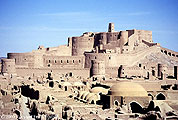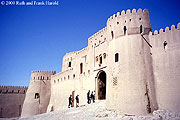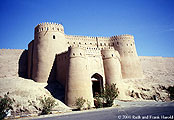
Back to Cities and Architecture
Click on thumbnails to enlarge them

THE CITADEL OF BAM
by
Frank Harold

In the southeast corner of Iran, where the high central plateau gives way to the low deserts of Sistan and Baluchistan, the small city of Bam dozes in its oasis. Surrounded by extensive groves of date palms that yield some of the country’s best fruit, it is a pleasant, nondescript place that gives the traveller a taste of Iran’s “hot lands”. The modern town, founded only in the 19th century, adjoins the abandoned walled city of earlier times, “ a vast ruin of broken vaults and domes, encased in its mud walls” (Stevens, 1962). Above the ruins looms what may be the world’s largest mud-brick castle, the Arg -e- Bam. The castle is spectacular and imposing, and often featured on posters published by Iran’s National Tourist Organization.
There has been a castle here, and a town, since at least Sassanian times (3rd to 7th century C.E.), for the road that now carries lorries to Pakistan follows an ancient trade route, a branch of the Silk Road. Ibn Hawkal, an Arab geographer of the 10th century C.E., described Bam as a sizeable town surrounded by palm groves. Nearby stood the celebrated castle, held to be impregnable. Cotton stuffs were manufactured here for export as far as Mesopotamia, also head-scarves, napkins and cloth for turbans. There were three mosques in the town, which was protected by a strong city wall with four gates (Cited in Le Strange, 1905); there is another mention of Bam from the 14th century.

The citadel of Bam was intended to guard the eastern approaches to the plateau, but failed repeatedly to stop marauding tribesmen from Afghanistan and Baluchistan; however, thanks to its remote location, the castle sometimes sheltered the losers in Iran’s internecine conflicts. One of the tragedies of that history played out in 1795, whe Lotf Ali Khan, last ruler of the Zand dynasty of Shiraz, sought refuge here from the ferocious Agha Muhammad Qajar; to no avail. The young prince was tortured to death, and his followers massacred; the pyramid of skulls erected to celebrate the occasion was still visible to a British traveller in 1810. Agha Muhammad’s unbridled cruelty frightened even his hard-boiled supporters, who arranged for his assassination. But the Qajar dynasty endured, to rule Iran until Reza Shah took power in 1921. Nearly fifty years after the Zand’s extinction, one Agha Khan Mahallati was more fortunate. The head of the schismatic Ismaili sect, and an offspring of the medieval Order of the Assassins, Agha Khan led an unsuccessful revolt against the Qajars. Following his defeat he holed up at Bam and then made his way to India; today’s Agha Khan is one of his descendants. It was presumably the incessant fighting that led Bam to be abandoned. The town was re-founded when firm central government was restored; the walled old city served as a military barracks until 1950, when restoration got underway.


For the visitor, Bam is outrageously romantic (images). No one now dwells in the old city, which once housed more than 10,000 inhabitants. You enter through a grand city gate, and then wander at will through the maze of alleys and mud-brick structures, past the remains of homes, mosques, schools, baths and at least one caravanserai. The ruins huddle inside magnificent mud-brick ramparts, some 3 km in length, studded with 28 watchtowers. The walls are said to date to the 9th century C.E.; some of the buildings are Safavid, but most are probably later. A steep passage leads through two further impressive gateways into the citadel itself. You pass the stables, the quarters of the garrison and several upscale residences, to emerge at last upon the highest pinnacle with its sweeping view over the ruins of the town and, beyond the walls, the oasis with its wealth of palm trees.
I have written of Bam as my wife and I saw it in 2000, but perhaps the past tense would have been more appropriate; for it is all gone, vanished in a few terrifying moments. On Dec 26th, 2003, about 4 AM, an earthquake struck Bam and drove the inhabitants out into the streets; when nothing further happened, they went back indoors. An hour and a half later, a far more powerful tremor devastated the city. Entire families were wiped out in an instant as the roofs collapsed on their heads. About 26,000 persons lost their lives (down from the initial estimate of 40,000), 10,000 were injured and 60,000 were left homeless; more than half the modern town was destroyed. The vast citadel, restored just a few years before, crumbled like a child’s sandcastle. Gates and walls shattered. The government of Iran and many foreign countries mobilized to assist the survivors and to begin rebuilding, but progress has been heartbreakingly slow. It will be many years before tourists return to gape in innocent amazement at Iran’s most photogenic citadel.
Sources
Information about the history of Bam can be found in G. Le Strange, The Lands of the Eastern Caliphate (1905; re-published by Al- Biruni, Lahore, Pakistan); and in an article by M.E. Bastani Parizi in the Encyclopaedia Iranica (E. Yarshater, ed; Routledge and Kegan Paul, London). Roger Stevens was ambassador of Great Britain to Iran when he wrote his charming account, The Land of the Great Sophy (Methuen and Co., London, 1962). Contemporary descriptions of Bam exist in any guidebook, including Lonely Planet’s Iran (P. Greenway and D. St. Vincent, 2nd edition, 1998), and The Travel Guide to Iran by M.T. Faramarzi (Yassavoli Publications, Tehran, 2000). For the earthquake see http://www.farsinet.com/bam/.

Back to Top
© 2006 Frank Harold.
Silk Road Seattle is a project of the Walter Chapin Simpson
Center for the Humanities at the University of Washington. Additional funding has been provided by the
Silkroad Foundation (Saratoga, California).